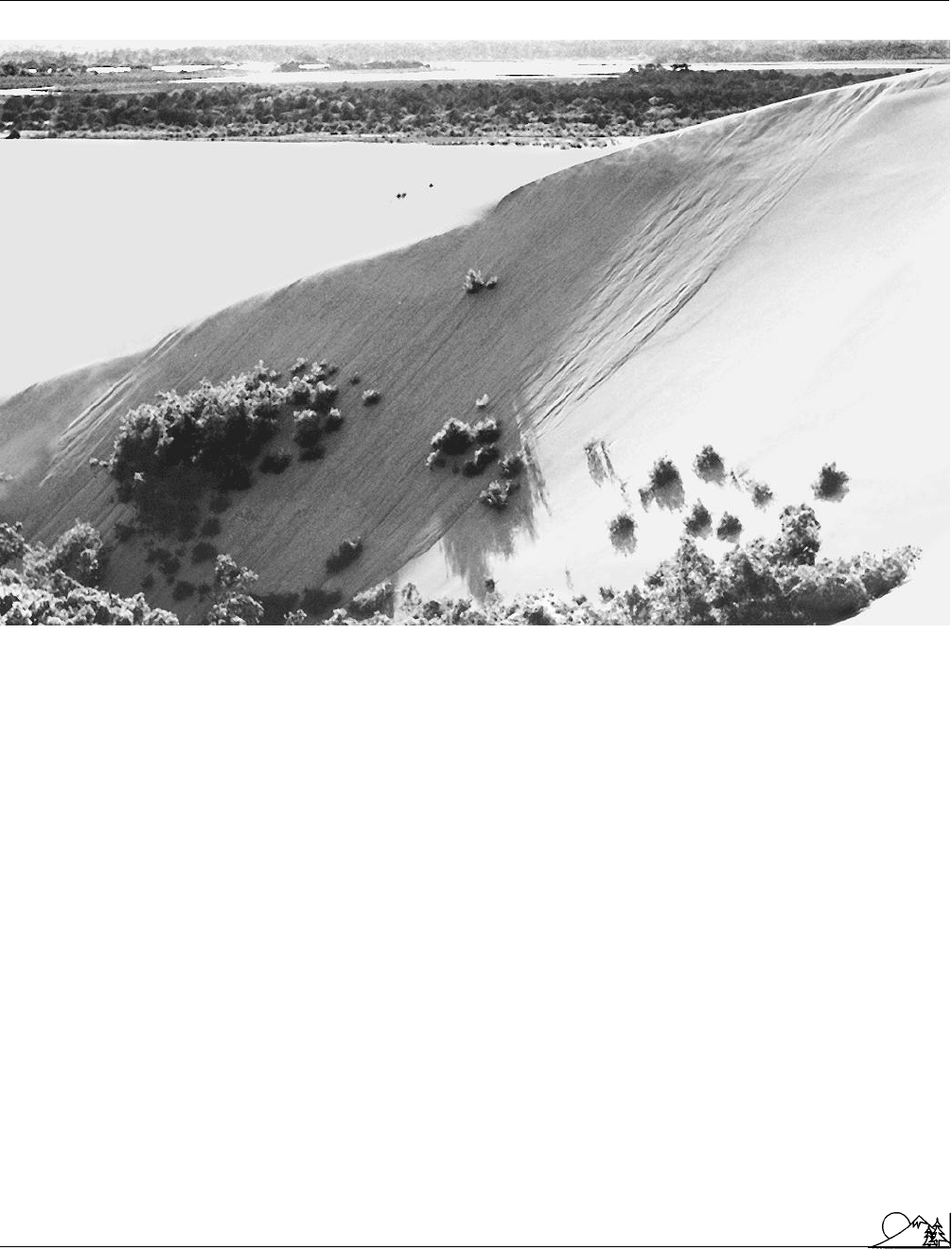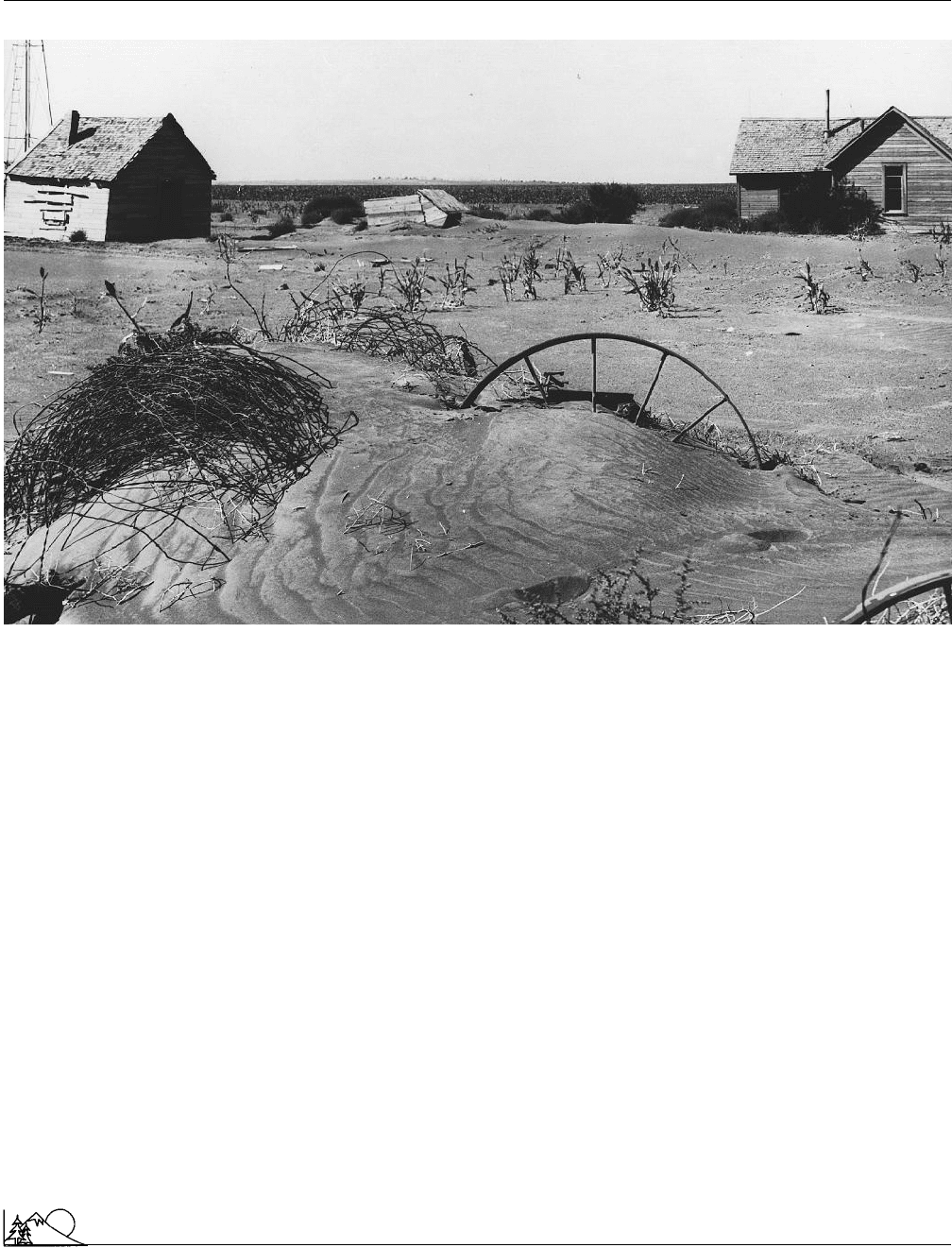Environmental Encyclopedia
Подождите немного. Документ загружается.


Environmental Encyclopedia 3
Dry cask storage
Of all the water on the earth, less than 3% is fresh
water. A lot of water is lost in evaporation, especially in
arid
climates, not only during rainfall but when it is stored in
surface reservoirs. Rainwater or snowmelt that seeps into
below-ground
permeable
rock channels, or aquifers, is
pumped into wells in many communities. High-tech pumps
have contributed to an increased drain on aquifers; if an
aquifer
is pumped too quickly, it collapses, and the ground
above sinks. To increase water bank supplies, some commu-
nities recharge their aquifers by pumping water into them
when they are low.
The only new water introduced into the
hydrologic
cycle
is purified ocean water.
Desalinization
plants are
expensive to build and maintain and often require burning
fossil fuels
or wood to run. Future plans include perfecting
retrieving
solar energy
and
wind energy
.
Currently, farm
irrigation
uses most of the world’s
fresh water supply, but as city populations grow, they are
expected to become the biggest consumers, and urban
con-
servation
measures will become imperative. Some commu-
nities already recycle
wastewater
for small farms and do-
mestic garden use. Drought-causing industrial pollutants
that “freeze” the water supply by rendering it toxic are being
reduced and resolved under federal law. Reduced or low-flow
shower heads and
toilets
are required in new construction in
some states.
Distributing water from more to less abundant supplies
by laying pipes and installing pumps within a state or a
country requires money and management. If water is fed
across state or international boundaries, legal and political
negotiations are necessary.
During severe drought, sociologists find that people
must either adapt, migrate, or die. Death, however, is usually
caused by other factors such as war or poverty, as in the
Sahel, where relief food supplies have been hijacked and
sold at high prices, or where people in remote villages must
walk to the distribution centers.
Some migrations have been permanent, as in the
mi-
gration
to California during the Midwestern
Dust Bowl
in
the 1930s. Others are temporary, as in the Sahel region,
where people migrate in search of food and water, crossing
country lines.
Most people adapt in drought by making the most of
their resources, such as building reservoirs or desalination
plants or laying pipes connecting to more abundant water
supplies. Farmers often invest in high-tech irrigation tech-
niques or alter their crops to grow low-water plants, such
as garbanzo beans.
Drought has also been the inspiration for inventions.
The American West at the turn of the twentieth century
gave rise to numerous rainmakers who used mysterious
chemicals
or noisemakers to attract rain. Most inventions
387
failed or were unreliable, but out of the impetus to make
rain grew silver iodide cloud-seeding, which now effects a
10–15% increase in local rainfall in some parts of the world.
[Stephanie Ocko]
R
ESOURCES
B
OOKS
Glantz, M. H., ed. Drought and Hunger in Africa: Denying Famine a Future.
New York: Cambridge University Press, 1987.
Dry alkali injection
A method for removing
sulfur dioxide
from
combustion
stack gas. A
slurry
of finely ground alkaline material such
as calcium carbonate is sprayed into the
effluent
gases before
it enters the smokestack. The material reacts chemically with
sulfur dioxide to produce a non-hazardous solid product,
such as calcium sulfate, that can then be collected by
filters
or other mechanical means. The technique is called dry
injection because the amount of water in the slurry is adjusted
so that all moisture evaporates while the chemical reactions
are taking place and a dry precipitate results. The use of dry
alkali injection can result in a 90% reduction in the
emission
of sulfur dioxide from a stack. It is more expensive than wet
alkali injection or simply adding crushed limestone to the
fuel, but it is more effective than these techniques and results
in a waste product that is relatively easy to dispose of. See
also Air pollution control
Dry cask storage
Dry cask storage is a method of storing the
radioactive
waste
from nuclear reactors. Dry cask storage refers to the
containers that hold the waste and the system of storing the
waste above ground in containers.
After World War II, nuclear
power plants
began
generating electricity. By the close of the twentieth century,
reactors at
nuclear power
plants generated 20% of the
electricity in the United States. To produce electricity,
ura-
nium
is used as fuel. Each tiny uranium pellet produces
almost as much energy as a ton of
coal
. The pellets are
contained in long metal rods, and these rods are placed in
a fuel assembly that hold from 50 to 300 rods.
The uranium undergoes fission, a process that heats
water and converts it to steam. The steam propels the blades
of a turbine. This in turn spins the shaft of a generator
where electricity is produced.
A large reactor uses 60 assemblies annually, and assem-
blies must be replaced after several years. The waste called
spent fuel is so radioactive that a person standing near an

Environmental Encyclopedia 3
Dry cleaning
unshielded rod would die within a second. The spent fuel
is also extremely hot. The used fuel rods are taken from the
reactor core and stored in a concrete pool that is lined with
steel. The rods are stored underneath at least 20 ft (6 m) of
water. The spent pool set-up serves as a radiation shield
while water cools the rods.
Spent fuel pools were regarded as temporary storage
facilities. When operators built the first reactors, there were
plans to extract and recycle unused uranium and
plutonium
from the fuel. However, the process would consolidate pluto-
nium into a form that could be used in
nuclear weapons
.
As a result of that consequence, the process was banned in
1977. By that time the United States had produced enough
plutonium to satisfy its own needs for weapons production.
Five years later, Congress passed the Nuclear Waste
Policy Act. Among the issues discussed was where to store
spent fuel because power plants were starting reach to storage
capacity. Congress amended the act in 1987 to designate a
permanent waste disposal site in the
Yucca Mountain
area
of Nevada.
Yucca Mountain had been proposed as a facility that
would open in 1985. However, concerns about a nuclear
explosion and other safety issues led to postponement of the
opening. The opening was shifted to 1989, 1998, 2003,
and 2010.
With no permanent site available, plant operators be-
gan to store spent fuel onsite in dry casks. In 1986, the
United States
Nuclear Regulatory Commission
(NRC)
licensed the first dry storage installation at the Virginia
Electric & Power Company Surry Nuclear Plant in James-
town, Virginia. The utility installed metal casks that were
16 ft (4.9 m) in height. Each dry cask held from 21 to 33
spent fuel assemblies. When filled, each cask weighed 120
tons. Casks were placed vertically on concrete pads that were
3-ft (1 m) thick. Each pad would hold 28 casks.
By 2001, the NRC had approved various dry casks
designs. The container is usually steel. After it is filled, the
container is either bolted or welded shut. The metal casks
are then put inside larger concrete casks to ensure radiation
shielding. Some systems involve placing the steel cask verti-
cally in a concrete vault. In other systems, the container is
placed horizontally in the concrete vault.
Discussions about dry cask safety in the twenty-first
century have centered on the Yucca Mountain proposal. In
May of 2002, the United States House of Representatives
voted to approve the plan. That vote was an override of
Nevada Governor Kenny Guinn’s veto of the plan to send
waste to Yucca. Opponents of the plan like the Nuclear
Information and Resource Service maintained that casks of
waste could not be transported safely by train or truck. In
2002, the facility was expected to cost $58 billion. It was
388
scheduled to open in 2010 and hold a maximum of 77,000
tons of waste.
[Liz Swain]
R
ESOURCES
B
OOKS
Murray, Raymond, and Judith Powell, ed. Understanding Radioactive Waste.
Columbus, OH: Battelle Press, 1997.
Saling, James, and Audeen Fentiman. Radioactive Waste Management. Phil-
adelphia, PA: Taylor & Francis, Inc., 2001.
O
RGANIZATIONS
Nuclear Information and Resource Service., 1424 16th Street NW, #404,
Washington, D.C. USA 20036 (202) 328-0002, Fax: (202)462-2183,
Email: nirsnet@nirs.org, <http://www.nirs.org>
United States Nuclear Regulatory Commission., One White Flint North,
11555 Rockville Pike , Rockville, MD USA 20852-2738 (301) 415-7000,
Toll Free: (800) 368-5642, Email: opa@nrc.gov, <http://www.nrc.gov>
Dry cleaning
Dry cleaning is a process of cleaning clothes and fabrics with
solutions that do not contain water. The practice has been
traced back to France where around 1825 turpentine was
used in the cleaning this process. According to Albert R.
Martin and George P. Fulton in Dry cleaning, Technology
and Theory, published in 1958, the tradition passed down
regarding the origins of dry cleaning states that the process
was discovered when “a can of ’camphene,’ a fuel for oil
lamps, was accidentally spilled on a gown and found to
clean it, and this discovery led to the first dry cleaning
establishment.” Because of this, dry cleaning was referred
to as “French cleaning” even into the second half of the
twentieth century.
By the late 1800s, naphtha,
gasoline
,
benzene
, and
benzol—the most common solvent—were being used for
dry cleaning. Fire hazards associated with using gasoline for
dry cleaning prompted the United States Department of
Commerce in March 1928 to issue a standard for dry clean-
ing specifying that a dry cleaning solvent derived from
petro-
leum
must have a minimum flash point (the temperature
at which it combusts) of 100°F (38°C). This was known as
the Stoddard solvent.
The first chlorinated solvent used in dry cleaning was
carbon
tetrachloride. It continued to be used until the 1950s
when its toxicity and corrosiveness were determined to be
hazardous. By the 1930s, the use of trichloroethylene became
common. In the 1990s the chemical was still being used in
industrial cleaning plants and on a limited basis in Europe.
This chemical’s incompatibility with acetate dyes used in
the United States brought about the end of its use in the
United States.
Tetrachloroethylene
replaced other dry
cleaning solvents almost completely by the 1940s and 1950s.

Environmental Encyclopedia 3
Dry deposition
In 1990 about 53% of worldwide demand for tetrachloroeth-
ylene was for dry cleaning, and approximately 75% of all dry
cleaners used it. However, in Japan petroleum-based solvents
continued in use through the 1990s. By the late 1990s,
perchloroethylene (perc or PCE) replaced tetrachloroethy-
lene as the predominant cleaning solvent.
When the United States
Environmental Protection
Agency
(EPA) issued national regulations to control air
emissions of perc from dry cleaners in September 1993,
environmental groups and consumers began to pay closer
attention to the possible negative impact this chemical could
have on human health. In July 2001, the American Council
on Science and Health issued a report concluding that perc
was not hazardous to humans at the levels most commonly
used in dry cleaning. The report noted that, “Perchloroethyl-
ene has been the subject of close government and public
scrutiny for more than 20 years. But government agencies
in the United States and around the world have not agreed
about the potential of environmental exposure to PCE to
cause adverse health effects, including
cancer
, in humans.”
The findings of this report included the following
items:
O
Inhalation of high levels of PCE and chemically similar
solvents can cause neurological effects such as nausea, head-
ache, and dizziness.
O
High inhaled doses have been linked to changes in blood
chemistry indicating that the liver and kidneys have been
affected.
O
These effects have been seen almost exclusively in workers,
particularly in the dry-cleaning and chemical industries.
O
There have been claims that reproductive difficulties are
associated with occupational exposure to PCE.
O
The claim that PCE is a
carcinogen
(cancer-causing sub-
stance) has received the most public and governmental
attention. Concern has been expressed that environmental
exposures to PCE in outdoor or indoor air and in drinking
water can cause cancer in humans.
O
Results of some epidemiological studies of dry cleaning and
chemical workers exposed to PCE have been interpreted to
suggest a relationship between occupational exposure and
various types of cancer. Careful examination of the way in
which these studies were conducted reveals serious prob-
lems including uncertainties about the amount of PCE to
which people were exposed, failure to take into account
exposure to other
chemicals
at the same time, and failure
to take into account known confounders. Due to these
deficiencies, these studies do not support a link between
PCE and cancer or other adverse effects in humans.
O
The differences between humans and rodents in the
me-
tabolism
and mechanisms of action of PCE make it un-
likely that the carcinogenic effects seen in mice and rats
389
administered high levels of PCE will occur in humans
exposed at environmentally relevant levels.
The environmental activist association
Greenpeace
also issued a report in July 2001, entitled, Out of Fashion
Moving Beyond Toxic Cleaners. This report urged the EPA
to classify perc as a probable human carcinogen. The report
claimed that up to 266 workers’ cancer deaths in New York,
Chicago, Detroit, and San Francisco were linked to perc.
As of 2002, the dry cleaning industry estimates that
approximately 36,000 dry cleaning establishments exist
across the United States, with about 200,000 people em-
ployed in the industry. Perc is used in at least 85% of dry
cleaning shops as the primary solvent. This means that if
perc is found to be a cancer causing chemical, many people,
including both workers in and people who live near dry
cleaning facilities, may be adversely affected.
[Jane E. Spear]
R
ESOURCES
B
OOKS
International Fabricare Institute. Environmental & Health Issues. 2002.
<http://www.ifi.org/industry>
U.S. Environmental Protection Agency. New Regulation Controlling Emis-
sions from Dry Cleaners. May 1994; June 2002. <http://www.epa.gov/
ttnsbap1>
Occupational Safety and Health Administration. Dry Cleaning. 2002.
<http://www.osha.gov/SLTC>
National Institute for Occupational Safety and Health. Drycleaning. 2002.
<http://www.cdc.gov/niosh>
American Council on Science and Health. The Scientific Facts about the
Dry-Cleaning Chemical Perc. 2001. <http://www.acsh.org/>
American Council on Science and Health. Science Group States Dry-Cleaning
Chemical Poses No Health Threat to Consumers. July 2001. <http://www.acsh.-
org/>
Martin, Albert; and George Fulton. Drycleaning, Technology and Theory.
New York: Textile Book Publishers, Inc., 1958.
Greenpeace USA. Dry Cleaning Chemical Linked to Hundreds of Deaths,
Warrants EPA Listing as Carcinogen. July 21, 2001. <http://www.green-
peaceuse.org/media/>
O
RGANIZATIONS
U.S. Environmental Protection Agency, 1200 Pennsylvania Avenue NW,
Washington, D.C. USA 20460 (202) 260-2090, , <www.epa.gov>
International Fabricare Institute, 12251 Tech Road, Silver Spring, MD
USA 20904 (301) 622-1900, Fax: (301) 236-9320, Toll Free: (800) 638-
2627, Email: techline@ifi.org, <http://www.ifi.org>
Neighborhood Cleaners Association, 252 West 29th Street, New York,
NY USA 10001 (212) 967-3002, Fax: (212) 967-2240, Email: sales@nca-
i.com, <http://www.nca-i.com>
Dry deposition
A process that removes airborne materials from the
atmo-
sphere
and deposits them on a surface. Dry deposition
includes the settling or falling-out of particles due to the

Environmental Encyclopedia 3
Dryland farming
influence of gravity. It also includes the deposition of gas-
phase compounds and particles too small to be affected by
gravity. These materials may be deposited on surfaces due
to their solubility with the surface or due to other physical
and chemical attractions. Airborne contaminants are re-
moved by both wet deposition, such as rainfall scavenging,
and by dry deposition. The sum of wet and dry deposition
is called total deposition. Deposition processes are the most
important way contaminants such as acidic sulfur com-
pounds are removed from the atmosphere; they are also
important because deposition processes transfer contami-
nants to aquatic and terrestrial ecosystems. Cross-media
transfers, such as transfers from air to water, can have adverse
environmental impacts, and an example of this is how dry
deposition of sulfur and
nitrogen
compounds can acidify
poorly buffered lakes. See also Acid rain; Nitrogen cycle;
Sulfur cycle
Dryland farming
Dryland farming is the practice cultivating crops without
irrigation
(rainfed agriculture). In the United States, the
term usually refers to crop production in low-rainfall areas
without irrigation, using moisture-conserving techniques
such as mulches and fallowing. Non-irrigated farming is
practiced in the Great Plains, inter-mountain, and Pacific
regions of the country, or areas west of the 23.5 in (600
mm) annual precipitation line, where native vegetation was
short
prairie
grass. In some parts of the world dryland
farming means all rainfed agriculture.
In the western United States, dryland farming has
often resulted in severe or moderate wind
erosion
. Alternat-
ing seasons of fallow and planting has left the land susceptible
to both wind and water erosion. High demand for a crop
sometimes resulted in cultivating lands not suitable for long-
time farming, degrading the
soil
measurably.
Conservation tillage
, leaving all or most of the previ-
ous crop residues on the surface, decreases erosion and con-
serves water. Methods used are stubble
mulch
, mulch, and
ecofallow. In the wetter parts of the Great Plains, fallowing
land has given over to annual cropping, or three-year rota-
tions with one year of fallow. See also Arable land; Desertifi-
cation; Erosion; Soil; Tilth
[William E. Larson]
R
ESOURCES
B
OOKS
Anderson, J. R. Risk Analysis in Dryland Farming Systems. Rome: Food
and Agriculture Organization of the United Nations, 1992.
390
Rene
´
Jules Dubos (1901 – 1982)
French/American microbiologist, ecologist, and writer
Dubos, a French-born microbiologist, spent most of his
career as a researcher and teacher at Rockefeller University
in New York state. His pioneering work in microbiology,
such as isolating the anti-bacterial substance gramicidin from
a
soil
organism and showing the feasibility of obtaining
germ-fighting drugs from
microbes
, led to the development
of antibiotics.
Nevertheless, most people know Dubos as a writer.
Dubos’s books centered on how humans relate to their sur-
roundings, books informed by what he described as “the
main intellectual attitude that has governed all aspects of
my professional life...to study things, from microbes to man,
not per se but in their complex relationships.” That pervasive
intellectual stance, carried throughout his research and writ-
ing, reflected what Saturday Review called “one of the best-
formed and best-integrated minds in contemporary civili-
zation.”
A related theme was Dubos’s conviction that “the total
environment” played a role in human disease. By total
envi-
ronment
, he meant “the sum of the facts which are not only
physical and social conditions but emotional conditions as
well.” Though not a medical doctor, he became an expert
on disease, especially tuberculosis, and headed Rockefeller’s
clinical department on that disease for several years.
“Despairing optimism” also pervaded Dubos’s human-
environment writings, his own title for a column he wrote
for The American Scholar, beginning in 1970. Time magazine
even labeled him the “prophet of optimism:” “My life philos-
ophy is based upon a faith in the immense resiliency of
nature,” he once commented.
Dubos held a lifelong belief that a constantly changing
environment meant organisms, including humans, had to
adapt constantly to keep up, survive, and prosper. But he
worried that humans were too good at adapting, resulting in
both his optimism and his despair: “Life in the technologized
environment seems to prove that [humans] can become
adapted to starless skies, treeless avenues, shapeless build-
ings, tasteless bread, joyless celebrations, spiritless plea-
sures—to a life without reverence for the past, love for the
present, or poetical anticipations of the future.” He stated
that “the belief that we can manage the earth may be the
ultimate expression of human conceit,” but insisted that
nature
is not always right and even that humankind often
improves on nature. As Thomas Berry suggested, “Dubos
sought to reconcile the existing technological order and the
planet’s survival through the
resilience
of nature and
changes in human consciousness.”
[Gerald L. Young Ph.D.]

Environmental Encyclopedia 3
Ducks Unlimited
Rene
´
Dubos. (Corbis-Bettmann. Reproduced by per-
mission.)
R
ESOURCES
B
OOKS
Piel, G., and O. Segerberg, eds. The World of Rene Dubos: A Collection from
His Writings. New York: Henry Holt, 1990.
Ward, B., and R. Dubos. Only One Earth: The Care and Maintenance of a
Small Planet. New York: Norton, 1972.
P
ERIODICALS
Culhane, J. “En Garde, Pessimists! Enter Rene Dubos.” New York Times
Magazine 121 (17 October 1971): 44–68.
Kostelanetz, R. “The Five Careers of Rene Dubos.” Michigan Quarterly
Review 19 (Spring 1980): 194–202.
Ducks Unlimited
Ducks Unlimited (DU) is an international (United States,
Canada, Mexico, New Zealand, and
Australia
), member-
ship organization founded during the depression years in
the United States by a group of sportsmen interested in
waterfowl
conservation
. DU was incorporated in early
1937, and DU (Canada) was established later that spring.
The organization was established to preserve and maintain
waterfowl populations through
habitat
protection and de-
velopment, primarily to provide game for sport
hunting
.
During the
Dust Bowl
of the 1930s, the founding members
of DU recognized that most of the continental waterfowl
391
populations were maintained by breeding habitat in the
wet-
lands
of Canada’s southern prairies in Saskatchewan, Mani-
toba, and Alberta. The organizers established DU Canada
and used their resources to protect the Canadian
prairie
breeding grounds. Cross-border funding has since been a
fundamental component of DU’s operation, although in re-
cent years funds also have been directed to the northern
American prairie states. In 1974 Ducks Unlimited de Mexico
was established to restore and maintain wetlands south of
the U.S.-Mexican border where many waterfowl spend the
winter months.
Throughout most of its existence, DU has funded
habitat restoration projects and worked with landowners to
provide water management benefits on farmlands. But, from
its inception DU has been subject to criticism. Early oppo-
nents characterized it as an American intrusion into Canada
to secure hunting areas. More recently, critics have suggested
that DU defines waterfowl habitat too narrowly, excluding
upland areas where many ducks and geese nest. The group
plans to broaden its focus to encompass preservation of these
upland breeding and nesting areas. Since many of these areas
are found on private land, DU also plans to expand its
cooperative programs with farmers and ranchers. Most com-
monly, however, DU is criticized for placing the interests
of waterfowl hunters above
wildlife management
concerns.
The organization does allow duck hunting on its preserves.
Following the fundamental principle of “users pay,”
duck hunters still provide the majority of DU’s funding. For
that reason DU has not addressed some issues that have a
serious effect on continental waterfowl populations. The
combination of illegal hunting and liberal bag limits is
blamed by some for the continued decline in waterfowl
numbers. DU has not addressed this issue, preferring to
leave management issues to government agencies in the
United States and Canada, while focusing on habitat preser-
vation and restoration. Critics of DU suggest that the organi-
zation will not act on population matters and risk offending
the hunters who provide their financial support.
In North America DU has expanded its scope and
activities to address ecological and
land use
problems
through the work of the North American Waterfowl Man-
agement Plan (NAWMP) and the Prairie CARE (Conser-
vation of Agriculture, Resources and
Environment
) pro-
gram. The wetlands conservation and other habitat projects
addressed in these and similar programs, not only benefit
game
species
, but other
endangered species
of plants
and animals as well. NAWMP (an agreement between the
United States and Canada) alone protects over 5.5 million
acres (2.2 million ha) of waterfowl habitat. In 2002, the
North American Wetlands Conservation Act (NAWCA)
granted the DU one million dollars to be put towards a new
wetlands in Ohio.

Environmental Encyclopedia 3
Ducktown, Tennessee
On balance, DU has had a major, positive impact
on North American waterfowl habitat and management.
Millions of acres of wetlands have been protected, enhanced,
and managed in Canada, the United States, and Mexico.
However, the continued decline in waterfowl populations
may require the organization to redirect some of its efforts
to population management and preservation issues.
[David A. Duffus]
R
ESOURCES
O
RGANIZATIONS
Ducks Unlimited, Inc., One Waterfowl Way, Memphis, TN USA 38120
(901) 758-3825, Toll Free: (800) 45DUCKS, <http://www.ducks.org>
Ducktown, Tennessee
Tucked in a valley of the Cherokee
National Forest
,on
the border of Tennessee, North Carolina, and Georgia,
Ducktown once reflected the beauty of the surrounding Ap-
palachian Mountains. Instead, Ducktown and the valley
known as the
Copper
Basin now form the only
desert
east
of the Mississippi. Mined for its rich copper lode since the
1850s, it had become a vast stretch of lifeless, red-clay hills.
It was an early and stark lesson in the devastation that
acid
rain
and
soil erosion
can wreak on a landscape, one of
the few man-made landmarks visible to the astronauts who
landed on the moon.
Prospectors came to the basin during a gold rush in
1843, but the closest thing to gold they discovered was
copper, and most went home. But by 1850, entrepreneurs
realized the value of the ore, and a new rush began to mine
the area. Within five years, 30 companies had dug beneath
the
topsoil
and made the basin the country’s leading pro-
ducer of copper.
The only way to separate copper from the zinc, iron,
and sulfur present in Copper Basin rock was to roast the
ore at extremely high temperatures. Mining companies built
giant open pits in the ground for this purpose, some as wide
as 600 ft (183 m) and as deep as a 10-story building. Fuel
for these fires came from the surrounding forests. The forests
must have seemed a limitless resource, but it was not long
before every tree, branch, and stump for 50 mi
2
(130 km
2
)
had been torn up and burned. The fires in the pits emitted
great billows of
sulfur dioxide
gas—so thick people could
get lost in the clouds even at high noon—and this gas mixed
with water and oxygen in the air to form sulfuric
acid
, which
is main component in acid rain. Saturated by acidic moisture
and choked by the remaining sulfur dioxide gas and dust,
the undergrowth died and the soil became poisonous to new
plants.
Wildlife
fled the shelterless hillsides. Without root
systems, virtually all the soil washed into the Ocoee River,
392
smothering aquatic life. Open-range grazing of cattle, al-
lowed in Tennessee until 1946, denuded the land of what
little greenery remained.
Soon after the turn of the century, Georgia filed suit
to stop the
air pollution
which was drifting out of this
corner of Tennessee. In 1907, the Supreme Court, in a
decision written by Justice Oliver Wendell Holmes, ruled
in Georgia’s favor, and the sulfur clouds ceased in the Copper
Basin. It was one of the first environmental-rights decisions
in the United States. That same year, the Tennessee Copper
Company designed a way to capture the sulfur fumes, and
sulfuric acid, rather than copper, became the area’s main
product. It remains so today.
Ducktown was the first mining settlement in the area,
and residents now take a curious pride not only in the town’s
history, but in the eerie moonscape of red hills and painted
cliffs that surrounds it. Since the 1930s, Tennessee Copper
Company, the
Tennessee Valley Authority
, and the
Soil
Conservation Service
have worked to restore the land,
planting hundreds of loblolly pine and black locust trees.
Their efforts have met with little success, but new reforesta-
tion techniques such as slow-release
fertilizer
have helped
many new plantings survive. Scientists hope to use the tech-
niques practiced here on other deforested areas of the world.
Ironically, many of the townspeople want to preserve a piece
of the scar, both for its unique beauty and the environmental
lesson of what human enterprise can do to
nature
, as well
as what it can undo. See also Acid waste; Ashio, Japan; Mine
spoil waste; Smelter; Sudbury, Ontario; Surface mining;
Trail Smelter arbitration
[L. Carol Ritchie]
R
ESOURCES
P
ERIODICALS
Barnhardt, W. “The Death of Ducktown.” Discover 8 (October 1987):
34-6+.
Dunes and dune erosion
Dunes are small hills, mounds or ridges of wind-blown
soil
material, usually sand, that are formed in both coastal and
inland areas. The formation of coastal or inland dunes re-
quires a source of loose sandy material and dry periods during
which the sand can be picked up and transported by the
wind. Dunes exist independently of any fixed surface feature
and can move or drift from one location to another over
time. They are the result of natural
erosion
processes and
are natural features of the landscape in many coastal areas and
deserts, yet they also can be symptoms of land degradation.
Inland dunes are either an expression of aridity or can be

Environmental Encyclopedia 3
Dunes and dune erosion
indicators of desertification—the result of long-term land
degradation in dryland areas.
Coastal dunes are the result of marine erosion in which
sand is deposited on the shore by wave action. During low
tide, the beach sand dries and is dislodged and transported
by the wind, usually over relatively short distances. De-
pending on the local
topography
and direction of the pre-
vailing winds, a variety of shapes and forms can develop—
from sand ridges to parabolic mounds. The upper few centi-
meters of coastal dunes generally contain chlorides from salt
spray and wind-blown salt. As a result, attempts to stabilize
coastal dunes with vegetation are often limited to salt-toler-
ant plants.
The occurrence of beaches and dunes together have
important implications for coastal areas. A beach absorbs
the energy of waves and acts as a
buffer
between the sea and
the dunes behind it. Low lying coastlines are best defended
against high tides by consolidated sand dunes. In such cases,
maintaining a wide, high beach that is backed by stable
dunes is desirable.
Engineering structures along coastal areas and the
mouths of rivers can affect the formation and erosion of
beaches and coastal dunes. In some instances it is desirable
to build and widen beaches to protect coastal areas. This
can require the construction of structures that trap littoral
drift, rock mounds to check wave action, and sea walls that
protect areas behind the beach from heavy wave action.
Where serious erosion has occurred, artificial replacement
of beach sands may be necessary. Such methods are expensive
and require considerable engineering effort and the use of
heavy equipment.
The
weathering
of rocks, mainly sandstone, is the
origin of material for inland dunes. However, whether or not
sand dunes form, depends on the vegetative cover condition
and use of the land. In contrast to coastal dunes, that are
often considered to be beneficial to coastal areas, inland
dunes can be indicators of land degradation where the pro-
tective cover of vegetation has been removed as a result of
inappropriate cultivation,
overgrazing
, construction activi-
ties, and so forth. When vegetative cover is absent, soil is
highly susceptible to both water and wind erosion. The two
work together in drylands to create sources of soil that can
be picked up and transported either downwind or down-
stream. The flow of water moves and exposes sand grains
and supplies fresh material that results in deposits of sand
in flood plains and ephemeral
drainage
systems. Before
dunes can develop in such areas, there must be long dry
periods between periodic or episodic sediment-laden flows
of water. Wind erosion occurs where such sand deposits
from water erosion are exposed to the energy of wind, or in
areas that are devoid of vegetative cover.
393
Where sand is the principle size soil particle and where
high wind velocities are common, sand particles are moved
by a process called saltation and creep. Sand dunes form
under such conditions and are shaped by wind patterns over
the landscape. Complex patterns can be formed—the result
of interactions of wind, sand, the ground surface topography,
and any vegetation or other physical barriers that exist. These
patterns can be sword like ridges, called longitudinal dunes,
crescentic accumulations or barchans, turret-shaped
mounds, shallow sheets of sand, or large seas of transverse
dunes. The typical pattern is one of a gradual long slope on
the windward side of the dune, dropping off sharply on the
leeward side.
Exposed sand dunes can move up to 11 yd (10 m)
annually in the direction of the prevailing wind. Such dunes
encroach upon areas, covering farmlands, pasture lands,
irri-
gation
canals, urban areas, railroads and highways. Blowing
sand can mechanically injure and kill vegetation in its path
and can eventually bury croplands or
rangelands
. If left
unchecked, the drifting sand will expand and lead to serious
economic and environmental losses.
Worldwide, dryland areas are those most susceptible
to wind erosion. For example, 22% of Africa north of the
Equator is severely affected by wind erosion as is over 35%
of the land area in the Near East. As a result, inland dunes
represent a significant landscape component in many
desert
regions. For example, dunes represent 28%, 26%, and 38%
of the landscape of the Saharan Desert, Arabian Desert, and
Australia
, respectively (Heathcote 1983). In 1980, Walls
estimated that 1.3 billion hectares of land were covered by
sand dunes globally. Although dunes can be symptoms of
land use
problems, in some areas they are part of a natural
dryland landscape that are considered to be features of beauty
and interest. Sand dune have become popular recreational
areas in parts of the United States, including the Great Sand
Dune National Monument in southern Colorado with its
229-yd (210-m) high dunes that cover a 158-mi
2
(254.4-
km
2
) area, and the Indiana Dunes State Park along the shore
of Lake Michigan.
When dune formation and encroachment represent
significant environmental and economic problems, sand
dune stabilization and control should be undertaken. Dune
stabilization may initially require one or more of the follow-
ing: applications of water, oil, bitumens emulsions, or chemi-
cal stabilizers to improve the cohesiveness of surface sands;
the reshaping of the landscape such as construction of fore-
dunes that are upwind of the dunes, and armoring of the
surface using techniques such as hydroseeding, jute mats,
mulching and asphalt; and constructing fences to reduce
wind velocity near the ground surface. Although sand dune
stabilization is the necessary first step in controlling this
process, the establishment of a vegetative cover is a necessary

Environmental Encyclopedia 3
Dunes and dune erosion
The dunes of Nags Head, North Carolina. (Photograph by Jack Dermid, National Audubon Society Collection. Photo Researchers
Inc. Reproduced by permission.)
condition to achieve long-term control of sand dune forma-
tion and erosion. Furthermore, stabilization and revegetation
must be followed with appropriate land management that
deals with the causes of dune formation in the first place.
Where dune erosion has not progressed to a seriously de-
graded state, dunes can become reclaimed through natural
regeneration simply by protecting the area against livestock
grazing, all-terrain vehicles, and foot traffic.
Vegetation stabilizes dunes by decreasing wind speed
near the ground and by increasing the cohesiveness of sandy
material by the addition of organic colloids and the binding
action of roots. Plants trap the finer wind-blown soil parti-
cles, which helps improve
soil texture
, and they also im-
prove the
microclimate
of the site, reducing soil surface
temperatures. Upwind barriers or windbreak plantings of
vegetation, often trees or other woody perennials, can be
effective in improving the success of revegetating sand dunes.
They reduce wind velocities, help prevent exposure of plant
roots from the drifting sand, and protect plantings from the
abrasive action of blowing sand. Areas that are susceptible
to sand dune encroachment can likewise be protected by
using fences or windbreak plantings that reduce wind veloci-
394
ties near the ground surface. Because of the severity of sand
dune environments, it can be difficult to find plant
species
that can be established and survive. In addition, any plantings
must be protected against exploitation, for example, from
grazing or fuelwood harvesting.
The expansion of sand dunes resulting from
desertifi-
cation
not only represent environmental problems, but they
also represent serious losses of productive land and a financial
hardship for farmers and others who depend upon the land
for their livelihood. Such problems are particularly acute in
many of the poorer dryland countries of the world and de-
serve the attention of governments, international agencies,
and nongovernmental organizations who need to direct their
efforts toward the causes of soil erosion and dune formation.
[Kenneth N. Brooks]
R
ESOURCES
B
OOKS
Brooks, K.N., P.F. Folliott, H. M. Gregersen and L. F. DeBano. Hydrology
and the Management of Watersheds. 2nd ed. Ames, Iowa: Iowa State Univer-
sity Press, 1997.

Environmental Encyclopedia 3
Dust Bowl
The effects of the Oklahoma dust bowl. (Corbis-Bettmann. Reproduced by permission.)
Folliott, P. F., K. N. Brooks, H.M. Gregersen and A.L. Lundgren. Dryland
Forestry—Planning and Management. New York: John Wiley & Sons, 1995.
Food and Agricultural Organization (FAO) of the United Nations. Sand
Dune Stabilization, Shelterbelts, and Afforestation in Dry Zones. Rome: FAO
Conservation Guide 10, 1985.
Dust Bowl
“Dust Bowl” is a term coined by a reporter for the Washington
(D.C.) Evening Star to describe the effects of severe wind
erosion
in the Great Plains during the 1930s, caused by
severe
drought
and lack of
conservation
practices.
For a time after World War I, agriculture prospered
in the Great Plains. Land was rather indiscriminantly plowed
and planted with cereals and row crops. In the 1930s, the
total cultivated land in the United States increased, reaching
530 million acres (215 million ha), its highest level ever.
Cereal crops, especially wheat, were most prevalent in the
Great Plains. Summer fallow (cultivating the land, but only
planting every other season) was practiced on much of the
land. Moisture, stored in the
soil
during the fallow (un-
cropped) period, was used by the crop the following year.
395
In a process called dust
mulch
, the soil was frequently clean
tilled to leave no crop residues on the surface, control weeds,
and, it was thought at the time, preserve moisture from
evaporation. Frequent cultivation and lack of crop canopy
and residues optimized conditions for wind erosion during
the droughts and high winds of the 1930s.
During the process of wind erosion, the finer particles
(
silt
and clay) are removed from the
topsoil
, leaving coarser-
textured sandy soil. The fine particles carry with them higher
concentrations of organic matter and plant nutrients, leaving
the remaining soil impoverished and with a lower water
storage capacity. Wind erosion of the Dust Bowl reduced
the productivity of affected lands, often to the point that
they could not be farmed economically.
While damage was particularly severe in Texas, Okla-
homa, Colorado, and Kansas, erosion occurred in all of
the Great Plains states, from Texas to North Dakota and
Montana, even into the Canadian
Prairie
Provinces. The
eroding soil not only prevented the growth of plants, it
uprooted established ones.
Sediment
filled fence rows,
stream channels, road ditches, and farmsteads. Dirt coated

Environmental Encyclopedia 3
Dust Bowl
the insides of buildings. Airborne dust made travel difficult
because of decreased
visibility
; it also impaired breathing
and caused
respiratory diseases
.
Dust from the Great Plains was carried high in the
air and transported as far east as the Atlantic seaboard. In
places, 3–4 in (7–10 cm) of topsoil was blown away, forming
dunes
15–20 ft (4.6–6.1 m) high where the dust finally came
to rest. In a 20-county area covering parts of southwestern
Kansas, the Oklahoma strip, the Texas Panhandle, and
southeastern Colorado, a soil-erosion survey by the
Soil
Conservation Service
showed that 80% of the land was
affected by wind erosion, 40% of it to a serious degree.
The droughts and resultant wind erosion of the 1930s
created widespread economic and social problems. Large
numbers of people migrated out of the Dust Bowl area during
the 1930s. The
migration
resulted in the disappearance of
many small towns and community services such as churches,
schools, and local units of government.
Following the disaster of the Dust Bowl, the 1940s
saw dramatically improved economic and social conditions
with increased precipitation and improved crop prices. Grad-
ually, changes in farming practices have also taken place.
Much of the severely damaged and marginal land has been
396
returned to grass for livestock grazing. Non-detrimental till-
age and management practices, such as
conservation tillage
(stubble mulch, mulch, and residue tillage); use of tree, shrub,
and grass windbreaks; maintenance of crop residues on the
soil surface; and better machinery have all contributed to
improved soil conditions. Annual cropping or a three-year
rotation of wheat-sorghum-fallow has replaced the alternate
crop-fallow practice in many areas, particularly in the more
humid areas of the West.
While the extreme conditions of drought and land
mismanagement of the Dust Bowl years have not been re-
peated since the 1930s, wind erosion is still a serious problem
in much of the Great Plains. According to the
Soil Conser-
vation
Service, the states with the most serious erosion
per unit area in 1982 were Texas, Colorado, Nevada, and
Montana. See also Arable land; Desertification; Overgrazing;
Soil eluviation; Tilth; Water resources
[William E. Larson]
R
ESOURCES
B
OOKS
Hurt, R. D. The Dust Bowl: An Agricultural and Social History. Chicago:
Nelson-Hall, 1981.
